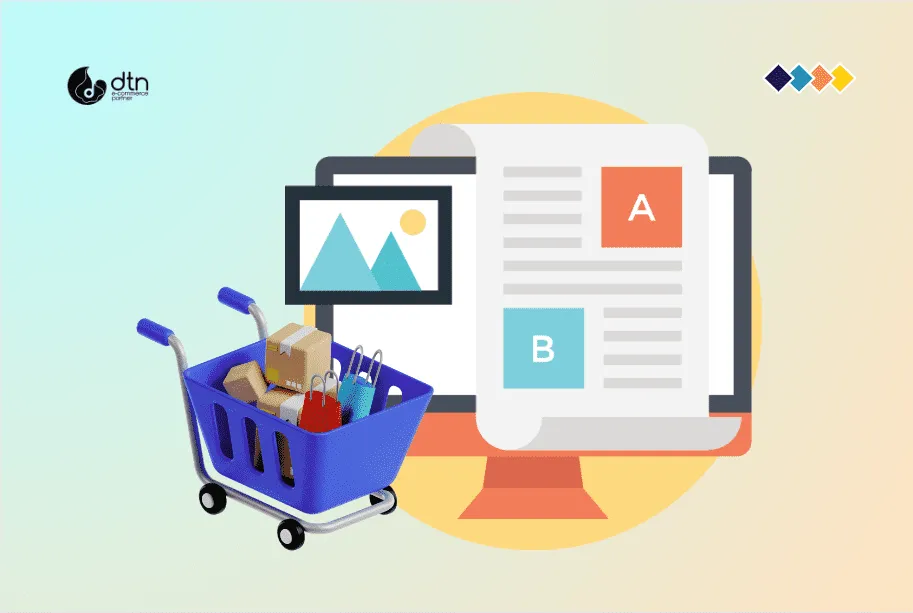In the fast-paced world of e-commerce, every click, every purchase, and every abandoned cart tells a story. As an e-commerce business owner, it’s crucial to understand what drives your customers’ behavior and optimize your website accordingly. That’s where A/B testing comes in.
Table of Contents
What is A/B Testing?
A/B testing involves comparing two versions of a web page to assess which one yields better performance based on predefined metrics such as click-through rates, conversion rates, or engagement levels. It involves randomly dividing your website traffic into two groups:
- Group Sees Version A of the page
- Group B Sees Version B of the page
You then track key metrics, such as conversion rate, bounce rate, and average order value, to determine which version is more effective.

Why is A/B Testing Important for E-commerce?
A/B testing is essential for e-commerce businesses because it allows you to:
- Identify areas for improvement: By testing different elements of your website, you can pinpoint what’s working and what’s not.
- Optimizing your conversion rate: This involves strategies aimed at increasing the percentage of website visitors who complete a desired action, whether it’s making a purchase, signing up for a newsletter, or any other predefined goal.
- Personalize the customer experience: Tailor your website to specific customer segments by testing different versions for different demographics or interests.
- Reduce bounce rate: Keep visitors engaged on your website by testing elements that improve their experience and reduce the likelihood of them leaving.
- Increase average order value: Encourage customers to spend more by testing different product recommendations, cross-selling strategies, and checkout processes.

How to Conduct an A/B Test
Conducting an A/B test involves the following steps:
- Define your hypothesis: Determine what you want to test and what you believe the outcome will be.
- Create two versions of the page: Make changes to the original page based on your hypothesis.
- Randomly split your traffic: Use a tool like Google Optimize or Optimizely to divide your website visitors into two groups.
- Set up tracking metrics: Determine the key metrics you want to track, such as conversion rate, bounce rate, and average order value.
- Run the test: Let the test run for a sufficient amount of time to collect statistically significant data.
- Analyze the results: Compare the results of the two versions to determine which one performed better.
- Implement the winning version: Make the changes from the winning version permanent on your website.

Best Practices for A/B Testing
- Test one variable at a time: Focus on changing only one element of your page, such as the call-to-action button or product placement.
- Use statistically significant data: Run your test for a long enough period to ensure that the results are reliable.
- Consider your audience: Test different versions for different customer segments, such as new visitors or returning customers.
- Be patient: A/B testing is an iterative process. Don’t expect to see results overnight.
Continuous optimization: Use A/B testing as an ongoing process to continually improve your website and maximize conversions.

Conclusion
A/B testing is a powerful tool that can help e-commerce businesses optimize their websites, increase conversions, and improve the customer experience. By following the best practices outlined in this guide, you can effectively use A/B testing to drive growth and success for your online store.
Frequently Asked Questions
We’ve compiled a list of answers to common questions.
What is A/B testing, and why is it important for e-commerce businesses?
A/B testing involves comparing two versions of a web page to assess their performance based on key metrics such as conversion rate, bounce rate, and average order value, helping to identify which version is more effective in achieving the desired goals. It’s important for e-commerce businesses because it allows them to identify areas for improvement, optimize conversion rates, personalize the customer experience, reduce bounce rates, and increase average order value.
How does A/B testing work, and what are the steps involved?
A/B testing involves dividing website traffic into two groups and showing each group a different version of a web page. The steps include defining a hypothesis, creating two versions of the page, splitting traffic randomly, setting up tracking metrics, running the test for a sufficient amount of time, analyzing the results, and implementing the winning version permanently.
What are some key metrics to track in A/B testing for e-commerce?
Key metrics to track in A/B testing for e-commerce include conversion rate (the percentage of visitors who complete a desired action), bounce rate (the percentage of visitors who leave the site after viewing only one page), and average order value (the average amount spent per order). These metrics help determine the effectiveness of different page versions in driving desired actions and revenue.
What are some best practices for conducting A/B tests in e-commerce?
Best practices for conducting A/B tests in e-commerce include testing one variable at a time to isolate effects, using statistically significant data by running tests for an adequate duration, considering audience segmentation for personalized experiences, being patient as A/B testing is an iterative process, and continuously optimizing based on insights gathered from tests.
How can e-commerce businesses leverage A/B testing to drive growth and success?
E-commerce businesses can leverage A/B testing to drive growth and success by systematically improving website performance, increasing conversion rates, enhancing user experience, and optimizing marketing strategies. By continuously testing and refining elements of their online store, businesses can stay competitive and maximize their revenue potential.



